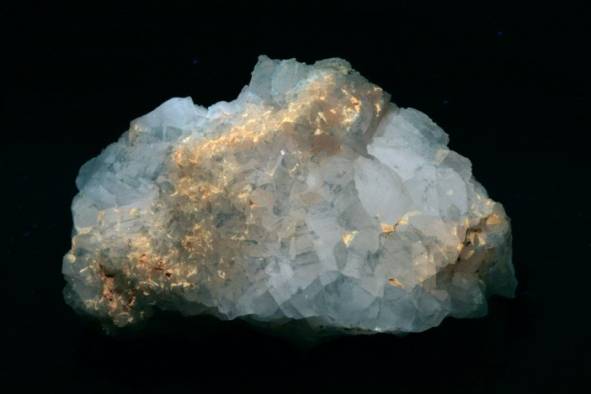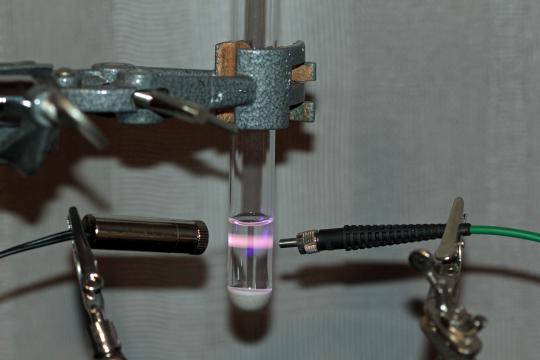
Colemanite: Emet Borate deposit, Emet, Kütahya Province, Aegean Region, Turkey.
The bluish to greenish white fluorescence of colemanite is partly intrinsically, partly due to organic substances, mainly humic acids. The Green phosphorescence is also due to these humic acids.
Short wave UV
Long wave UV
Colemanite: Emet Borate deposit, Emet, Kütahya Province, Aegean Region, Turkey.
The bluish to greenish white fluorescence of colemanite is partly intrinsically, partly due to organic substances, mainly humic acids. The Green phosphorescence is also due to these humic acids. The orange-yellow fluorescence is most likely due to a complex of calcium with humic acids (calcium-dihumate)
Colemanite, Bigadiç, Balikesir Province, Marmara Region, Turkey
White crystals that have grown on a matrix of fibrous colemanite. The younger white crystals exhibit the usual greenish-white fluorescence but the older colemanite aggregates fluoresce bright orange under longwave UV. The cause of this fluorescence is the presence of a complex of calcium with humic acids. I investigated this atypical fluorescence in the context of a study in collaboration with the University of Izmir, Turkey. The study was published in: Journal of Mineralogy and Geochemistry, Volume 194, Number 1, January 2017, pp. 1-17 (17),
Fluorescence survey of Turkish borate minerals: comparative measurements of fluorescence spectra of the most important borate mineral species, Turkey.
Authors: Helvacı, Cahit; Öztürk, Yeşim Yücel; Emmermann, Axel (MKA)
Colemanite: Hisarcik Mine, Emet Borate deposit, Emet, Kütahya Province, Aegean Region, Turkey
This specimen has reference EH-1 in the study:Fluorescence survey of Turkish borate minerals: Fluorescence survey of Turkish borate minerals: comparative measurements of fluorescence spectra of the most important borate mineral species, Turkey.
Authors: Helvacı, Cahit; Öztürk, Yeşim Yücel; Emmermann, Axel (MKA)
This is a fine aggregate of centimeters large, flat colemaniet crystals. There is also some material of volcanic origin (Ignimbrite) enclosed and clay-like dirt. The typical Orange fluorescence of calcium-humic acids complex is dominant but there are also clearly a number of green fluorescent crystals. This is clearly a uranyl contamination. However, no uranium minerals have been found in this locality (according to MinDat).
Long wave UV and halogen light
Short wave UV and halogen light
Cahnite: Emet Borate deposit, Emet, Kütahya Province, Aegean Region, Turkey.
Cahnite is an arsenoborate. Many arsenoborates exhibit a yellow fluorescence. There is virtually no literature on the fluorescence of this mineral. It is quite possible that its fluorescence is intrinsic. Cahnite is, in itself, a fairly rare mineral but it is rather common in the arsenic rich Borate deposits of Turkey, sometimes also as a contaminant in and on other Borate minerals.
Cahnite on colemanite: Emet Borate deposit, Emet, Kütahya Province, Aegean Region, Turkey.
Small spheric aggregates of acicular cahnite on top of larger colemanite crystals. The fierce fluorescence of the cahnite aggregates are backlit by the softer, almost eerie greenish fluorescence of the colemanite.
Short wave UV and halogen light
Short wave UV and halogen light
Colemanite: Kirka, Eskişehir Province, Central Anatolia Region, Turkey
Large double terminated colemanite twin. The specimens shows the common greenish fluorescence, which is intrisic, but there is a hint of yellow in there too. Are there some finely dispersed arsenoborates contaminating this specimen?
Colemanite wit ulexite: Kirka, Eskişehir Province, Central Anatolia Region, Turkey
Large euhedral colemanite crystals under both normal light and long wave UV. The fluorescence is common for this mineral; a greensh white. The backside of this mineral is more interesting. Long needle-like crystals of ulexite are organized in sheaves. The ulexite has no noticeable fluorescence, intrinsic or other, but appears to be lighted from within by the cores of colemanite around which it has grown.
Colemanite, Bigadiç, Balikesir Province, Marmara Region, Turkey
This specimen is made up of beautiful radiant spheres of acicular crystals and coarse-grained crystalline colemanite. Noteworthy is that the well-crystallized material exhibits the “normal” whitish intrinsic fluorescence, while the coarser material and the inclusions of clay from the soil and volcanic debris fluoresce bright orange. The Orange fluorescence is almost certainly due to a complex of calcium with humic acids.
Normal light and long wave UV
Colemanite, Bigadiç, Balikesir Province, Marmara Region, Turkey
A saw cut of massive white colemanite, surrounded by grey fibrous colemanite. The white part exhibits the intrinsic fluorescence of pure colemanite. The surrounding material is riddled with imbrignite and material from the soil. It also contains a high concentration of what, after analysis, appears to be a calcium-dihumate complex. This specimen was completely ground up to powder to demonstrate the presence of this complex. The substance that causes the orange fluorescence can be extracted from the powdered mineral by means of acetone (see photo below)
A violet laser marks a fluorescent path through the acetone with which the substance was extracted. The orange fluorescence is less than saturated, due to the presence of some blue-green fluorescence of free (non-complexed) humic acids. To the right of the test tube is the optic fibre through which the spectrum was recorded.
Normal light and LW+MW UV
Colemanite, Kestelek Mine, Mustafa Kemalpafla, Bursa Province,
Marmara Region, Turkey
Large, perfectly formed colemanite crystals. Some parts of the large crystal are covered with a rougher layer that is also colemanite. The largest crystal faces fluoresce weak red under longwave UV, while the rest of the specimen shows the common intrinsic fluorescence of colemanite. It seems that the cause of the red fluorescence, the calcium-dihumate complex, was preferentially absorbed by the largest crystal faces. This makes sense, since a contamination is more easily absorbed by the fastest-growing areas, thus the largest crystal faces. We see something similar in the fluorescence of hourglass gypsum.
White light and 405 nm laser resp.
Borax, Kirka, Eskişehir Province, Central Anatolia Region, Turkey
Very hygroscopic massive specimen that was originally almost transparent. Such borax specimens can be reduced to a puddle in a few hours. Even when well protected from atmospheric humidity, there is nearly always a layer of weathering forming rapidly. The red fluorescence is virtually only visible under violet laser light of 405 nm. Its cause lies in the absorption of a complex of calcium and humic acids during the formation of the mineral. (See Spectrum, bottom right.)
Tunellite: Kirka, Eskişehir Province, Central Anatolia Region, Turkey
Nodules of a few centimeters large, covered with a weathering layer. The fluorescence is visible but not very strong. The cause of the fluorescence is the same as with most colemaniet specimens: Intrinsic plus that of some organic material.
Normal light and LW+MW UV
Colemanite
Colemanite
Colemanite
Colemanite
Cahnite
Cahnite
Colemanite
Colemanite with ulexite
Colemanite
Colemanite
Colemanite
Borax
Tunellite







